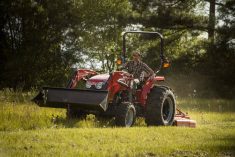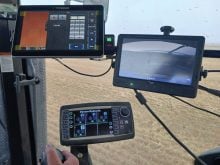Ontario company Salford holds distinction of building the world’s largest granular fertilizer carts
BRANDON – The growing trend today sees farmers shifting toward precision agriculture and more prudent and exact placement of fertilizer in the soil.
Bucking that trend, Salford continues to make a big splash with their granular spreaders. The reason is efficiency.
The latest versions of Salford’s BBI and 9620 carry 20 tons of granular fertilizer, making them the world’s largest granular carts. Although the two carts are similar in basic design, the $135,000 BBI is a spinner and the $200,000 9620 is a pneumatic boom machine.
The BBI covers a uniform spread of up to 120 feet, according to Salford’s Doug Achtymichuk.
Read Also

Growing garlic by the thousands in Manitoba
Grower holds a planting party day every fall as a crowd gathers to help put 28,000 plants, and sometimes more, into theground
“The BBI is totally ISO BUS compatible and computer controlled. Once you do your density test, then you weigh out your product and do the pan test to make sure the product will be spread uniformly over the entire 120 feet,” says Achtymichuk.
The standard BBI spinner is the MagnaSpread, which delivers consistent 80-foot swaths. The Magna can be configured for variable rate, with three compartments in the bin to accommodate three different nutrients. The optional Javelin spinner is interchangeable with the Magna. It delivers consistent 120-foot swaths.
In 2017, Salford introduced split conveyor chains so the operator can throw to only the left or right side. The high duty cycle hydraulic system allows continuous spreading on larger farms or in commercial operations.
The BBI is available with a choice of three suspensions; adjustable axle, torsion axle or walking beam axle. It can be set up as a pull-type trailer, mounted on a floater chassis, mounted on a high-clearance chassis or on an ag truck.
The 9620 air boom is capable of applying up to 110 acres per hour. Left and right booms can be managed independently of each other. The 17-inch fan is hydraulically driven. Hydraulic requirements are 30 gallons per minute at 2,800 pounds per sq. inch, with four remotes.
The 9620 is capable of variable rate, with two separate product compartments. The booms can be hydraulically raised up to eight feet at the tips. The chassis uses a walking beam undercarriage.
“The machines each weigh in at about 23,000 pounds empty. So it gets to be pretty heavy when fully loaded. You do need a fairly large tractor, at least 350 (horsepower). The largest models of front-wheel assist tractors are adequate, but most guys prefer a 350 or 400 hp four-wheel drive.


















